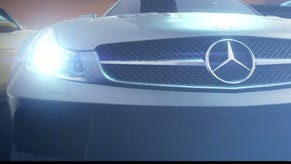Face-Off: Need for Speed: Most Wanted on Wii U
Wii U-tiful.
If there's any developer ready to give brand new console hardware a fair shake, it's Criterion Games. From Burnout Paradise to its celebrated reinventions of the Need for Speed series, the studio has an impeccable record turning in tightly matched games on 360 and PS3 platforms alike, with no-one left wanting. With the hotly anticipated Wii U version of Need for Speed: Most Wanted it aims to go one better. By no means a straight port, the boat is being pushed out much further this time with its suite of unique GamePad features, improved PC-grade textures courtesy of the console's 1GB of RAM, and a greatly revamped approach to its night-time lighting.
So can this new edition truly be taken as the definitive version? In our original Face-Off feature, it was inevitably the PC version that offered the greatest number of perks in resolution, shadow quality, reflection mapping and object draw distance. However, the two console versions held up to the Guildford studio's long-held standards for parity, with only an occasional lead in frame-rate on Sony's platform dividing the two in the final tally. One immediate benefit of waiting an extra five months for the Wii U version is the inclusion of the first 'Unlimited Speed' DLC pack as standard, plus any basic engine refinements that had been applied to these initial releases.
Alas, these optimisations aren't all included on the disc, and booting the game still demands a sizable 156MB patch install to bring the version up to 1.1.0. With everything set up though, we pit the visual quality of this release against the PC, 360 and PS3 versions with the head-to-head video below - plus our quad-format comparison gallery. Due to the dynamic nature of the game's day-night cycle, it is worth noting that there are minor differences in shadow positions at various points.
From the off, it's a strong start for the Wii U, boasting the very same resolution as its console counterparts. There's a slim, 8-pixel high border to both the top and bottom of the output, which reduces the effective resolution to the familiar 1280x704 value spotted in our last analysis. This minor concession is designed to suit each platform's limited memory bandwidth while avoiding any upscale which might muddy over the image - though thankfully this is absent from PC. On top of this we have a post-processing pass which aggressively attacks aliasing artifacts. This approach may not appeal to all eyes since many fine details are ultimately blurred over, but the overall quality falls in line with the other console versions.
"Criterion has made good on its promises to deliver a more visually rich version of the game for Wii U owners."
Alternative comparisons:
Looking to the promised texture bump, a clear upgrade is in effect which gives us crisper-looking concrete roads, tyre patterns, hubcap designs and building fronts. These end up matching the sharpness of the PC version's higher settings, leaving the PS3 and 360 looking a tad smudged by comparison - especially during the cinematic sequences that roll before each race. However, the bump is only made to specific areas, with lower-priority surfaces like the roads' painted white lining still relying on console-grade textures. In this sense, the Wii U offers something of a middle ground between the PC version at maximum texture quality and that which we've already seen on consoles.
Reflection-mapping also benefits from an upgrade to a similar midway degree on Wii U, particularly where puddles are strewn across busy urban streets. Once again, only certain buildings are reflected on 360 and PS3 - the side effect being that floors appear brighter as a result of a more of the sky being revealed. On the other hand, the Wii U has more in common with PC by mirroring most geometry at a distance, which creates a darker and more natural look to glistening road surfaces. Again, the draw distance on these reflections doesn't quite extend as far as a high-end PC can, but it's an improvement over the other home consoles nevertheless.
Criterion Games makes a big point of showing off its revamped night-time lighting by having Most Wanted start off at midnight on Wii U. During the day, little has perceptibly changed, but once dusk hits it's clear the world is engulfed in a more intense pitch of black - a move that accentuates the glow from particle lighting, coloured sign-posts and street-lamps. The contrasts are more stark now, but the lighting ultimately sits better with the environment. However, the upshot is that streets now appear less saturated in colour, which puts an emphasis on using a car's headlights to navigate poorly-lit roads. The alternative is, of course, to switch back to day via the GamePad's 'co-driver' controls, which causes the sun to whip across the sky in a stylish time-lapse motion.



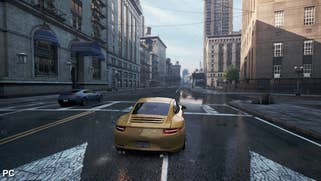
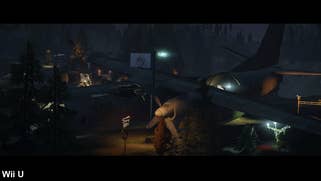
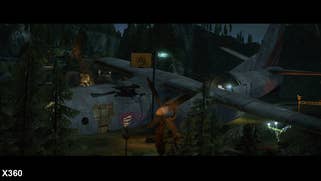
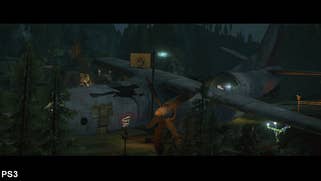
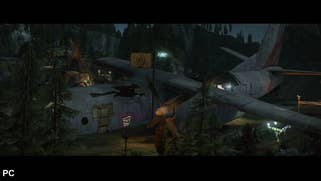


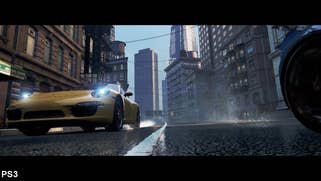


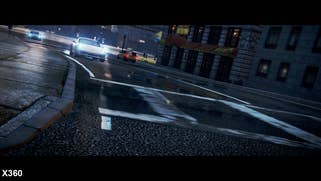
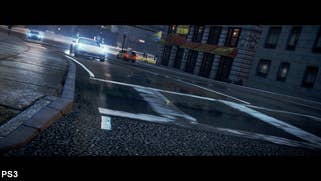
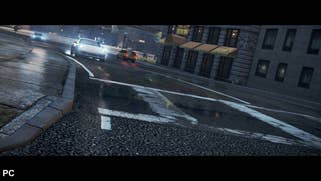
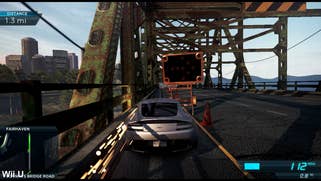
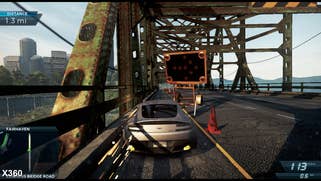
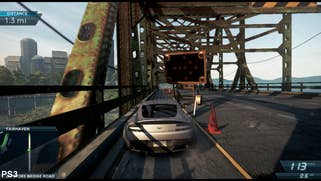

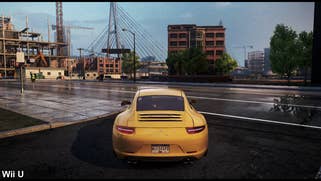


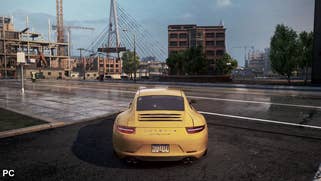
Elsewhere, the tweaks are either less obvious or non-existent. The Wii U puts out an equivalent quality of motion blur, particle effects and alpha to the PS3 and 360 versions. Car shadows still look blocky from afar, and smoke from screeching tyres continues to bring out a heavy sawtooth effect across surrounding geometry. This indicates a low-resolution alpha is at play, which has the Wii U falling in line with the PC's lowest visual effects setting. The geometry seen on buildings is identical to the other console versions too, as is the draw distance on cars, bollards and traffic lights, with pop-in only being faintly detectable when careening across busy cityscapes.
Off-screen play is in. Most Wanted can be played entirely through the GamePad's 6.2-inch screen at the touch of a corner button, the downsizing of which helps to hide these visual nips and tucks. The HUD elements and overall field of view are well tailored to this size of screen, which makes oncoming traffic easier to spot than the smaller-yet Vita version when travelling at speed. Failing that, the option to turn AI cars off altogether ties in nicely with this method of playing the game, though this still involves switching between screen modes to view the co-driver menu. Nevertheless, it's eminently playable in this form thanks to the game's pick up and play nature; a true stand-out feature when stood next to the other releases.
When the action is on the HDTV, your options open up massively. Touch-screen controls essentially give us a god-mode; six giant buttons pop up which allow Fairhaven to be manipulated in various ways. Besides toggles for traffic and light, it's possible to hop into any car without needing to fish them out from the urban wilderness. For those being pursued by cops, a giant map also comes in handy for spotting upcoming speed cameras or security gates, with an option to disrupt cop radars at the ready. This doesn't upset the balance of the game too radically; rather, it simply peels away the attention of one vehicle. Being followed by a very short cooldown, use of the ability also has to be timed well for it to serve any real advantage in your escape.
"Co-driver mode aims to make the game more accessible for Wii U owners and it does so without impacting the core experience."
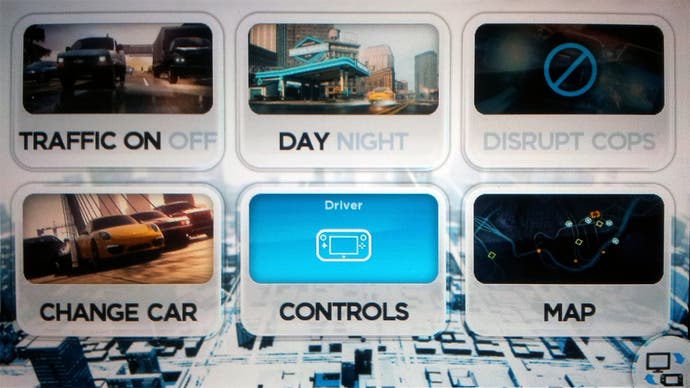
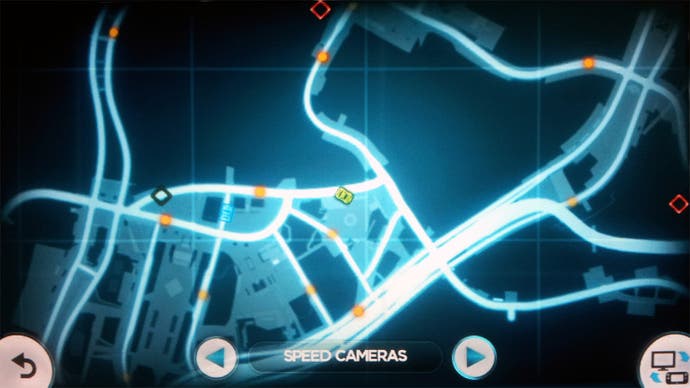
Undoubtedly the biggest disappointment with the Wii U release is the cut-down player count in online multiplayer, offering a maximum of six racers rather than the eight possible on other consoles. Seeing as the competitive element counts as the most compelling part of the package, such a compromise can't have been made lightly, and we do wonder what technical explanation there is be for this limitation. As a plus for those concentrating on exploring Fairhaven, there are several Nintendo-themed secrets littered around the world - the specifics of which we'd rather not spoil - plus the bundling of the very first 'Ultimate Speed' DLC. There's plenty of single-player content to discover, but speaking on the game's longevity, the status of the Velocity, Heroes, and Movie Legends packs remains up in the air. However, creative director Alex Ward has hinted that anything could be possible, given enough sales for the version.
Need for Speed: Most Wanted - performance analysis
With all of its GamePad-based features and visual tweaks, a concern is rightly raised that the low 1.24GHz core clocks of the Wii U's CPU may be a limiting factor for performance - an issue that came to a head with the choppier frame-rate of the Black Ops 2 port. From the onset, the setup for Most Wanted remains the same as on Sony and Microsoft hardware: it's a 30FPS target with permanently engaged v-sync to cut out all tearing.
Looking at a mixture of pre-race cinematics and intense city races, it's clear the Wii U version makes good on that promised 30FPS. Very good, in fact - rather than being bogged down by the extras, we're instead seeing a frame-rate that sticks to its target more diligently than either the PS3 or 360 versions. In each case, the worst hits to performance coincide with too many cars, physics-based action involving crashes, or excesses of on-screen alpha. Dust clouds appearing around tyres brings that refresh hurtling down to a constant 20FPS on rival consoles, but the Wii U dips to just 25FPS for that same duration. It's a clear result that tips the scales even further in favour of this latest version of the game.
As performance goes, the only true drawback we can pick out relates to the stability of the game. While posters on NeoGAF are divided on the frequency of hard-locks - with some suffering many, and others none - we can report that in our five hours of play we've experienced only a single lock. Curiously, this kicked in just as we stumbled upon one of the Nintendo-themed secret areas, though the Home button also ranks as a common factor in these reports.
"GPU bottlenecks on PS3/360 aren't as much of an issue on Wii U, though there are occasions when the older consoles manage to pull ahead."
Touching on loading times, the Wii U delivers a solid turnaround which holds up to the 360 version when installed to HDD. Put to a practical test, the Emerson Beltway stage takes the 360 and Wii U releases 15 seconds to load for the first time, while the PS3 trails the pack at 22 seconds. Fortunately, once a level is cached to each respective console's memory, the time for retries is reduced significantly to just eight seconds apiece - an ideal situation for Autolog users striving to beat a friend's record time.
Need for Speed: Most Wanted on Wii U - the Digital Foundry verdict
All in all, having taken a decade-long break from Nintendo since the release of Burnout 2 on GameCube, Criterion Games has used the Wii U to conjure up the definitive console version of Need for Speed: Most Wanted. It's not an overwhelming advance that matches the visual fidelity of the PC version in all regards, but additions and tweaks are numerous and well-considered. At no expense to the frame-rate, textures stand at the midway point in the quality spectrum, between the more blurry assets we're seeing on PS3 and 360 and the highest possible settings on PC. It's a worthwhile upgrade that extends to reflection draw too, with all other visual facets being identical, and the frame-rate coming away smoother regardless.
Tweaks to night-time lighting are welcome too, bringing a more natural darkness to the environments, while at the same time enhancing the look of directional lights. It's a bold change when compared to the more vibrant lighting of the previous releases, and crucially one which doesn't interfere with the core racing experience. There are shortcomings to the Wii U package that must be noted though; starting with the uncertain release schedule of future DLC, and the cut down to six players for online play. The lack of analogue triggers on both the GamePad and Classic Controller Pro may also be a factor for some, where re-mapping acceleration to the right analogue stick is a necessary workaround for those who prefer to modulate their speed.
In summary, this ranks as the version to get if those points can be overlooked. The conversion is a sound one, and GamePad features are well-implemented and useful - if not all absolutely essential. Many are luxuries, such as the ability to hop into any car immediately, which ultimately make exploring Fairview a much easier experience. Meanwhile, the inclusion of off-screen play brings this version to life in a way no other release can at this time. When considering the mixed quality of ports that have hit the Wii U so far, this ranks among the stronger and most committed efforts to cater for its strengths - a tradition we hope will long continue.




